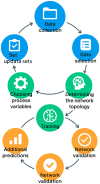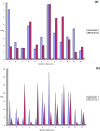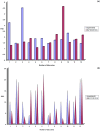The Role of Artificial Intelligence in Predicting the Progression of Intraocular Hypertension to Glaucoma
- PMID: 40566519
- PMCID: PMC12194571
- DOI: 10.3390/life15060865
The Role of Artificial Intelligence in Predicting the Progression of Intraocular Hypertension to Glaucoma
Abstract
AI systems, especially artificial neural networks (ANNs), are increasingly involved in the diagnosis and personalized management of ophthalmologic disorders.
Background: This study shows the practical applications of artificial intelligence for predicting the progression of intraocular hypertension (IOH) to glaucoma.
Methods: This study involved two groups of patients with IOH and a control group, analyzed using the commercial Neurosolution simulator. The findings were compared with experimental data. The performance of the neural models was evaluated using several metrics: Mean Squared Error (MSE), Normalized Mean Squared Error (NMSE), correlation coefficient (r2), and percentage error (Ep).
Results: For all three patient groups, the best performance was achieved with neural networks featuring two hidden layers: MLP(9:18:9:3) for group 1, MLP(10:20:10:3) for group 2, and MLP(10:30:20:3) for group 3. The MSE values during validation were 0.39 for groups 1 and 2, and 0.34 for group 3. For these neural networks, the probability of producing correct outputs during validation was 75% (i.e., 9 correct responses out of a possible 12). The findings in this study are in line with those reported by other researchers in the field.
Conclusions: The neural network models developed in this study demonstrated their potential for predicting the progression of intraocular hypertension to glaucoma.
Keywords: artificial intelligence; artificial neural networks; glaucoma; intraocular hypertension.
Conflict of interest statement
The authors declare no conflicts of interest.
Figures


















Similar articles
-
Artificial intelligence for detecting keratoconus.Cochrane Database Syst Rev. 2023 Nov 15;11(11):CD014911. doi: 10.1002/14651858.CD014911.pub2. Cochrane Database Syst Rev. 2023. PMID: 37965960 Free PMC article.
-
Laser trabeculoplasty for open-angle glaucoma and ocular hypertension.Cochrane Database Syst Rev. 2022 Aug 9;8(8):CD003919. doi: 10.1002/14651858.CD003919.pub3. Cochrane Database Syst Rev. 2022. PMID: 35943114 Free PMC article.
-
Surgical interventions for bilateral congenital cataract in children aged two years and under.Cochrane Database Syst Rev. 2022 Sep 15;9(9):CD003171. doi: 10.1002/14651858.CD003171.pub3. Cochrane Database Syst Rev. 2022. PMID: 36107778 Free PMC article.
-
Perioperative medications for preventing temporarily increased intraocular pressure after laser trabeculoplasty.Cochrane Database Syst Rev. 2017 Feb 23;2(2):CD010746. doi: 10.1002/14651858.CD010746.pub2. Cochrane Database Syst Rev. 2017. PMID: 28231380 Free PMC article.
-
SMOTE-Enhanced Explainable Artificial Intelligence Model for Predicting Visual Field Progression in Myopic Normal Tension Glaucoma.J Glaucoma. 2025 Jul 1;34(7):520-527. doi: 10.1097/IJG.0000000000002579. Epub 2025 Apr 21. J Glaucoma. 2025. PMID: 40249240
References
LinkOut - more resources
Full Text Sources

